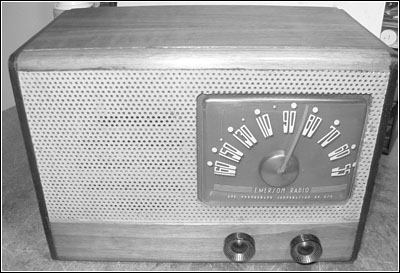Of Old Radios And Related Items--Published Monthly
The Emerson Model 535
Value -- Utility -- ServiceBY RICHARD ARNOLD
Once again Richard Arnold reminds us of the important role Emerson played in radio history. Here is another model of the kind of small table radio that became common in American homes in the 1930s. (Editor)
For years one of Emerson's slogans was "World's Biggest Selling Little Radio." With the advent of small radio, the public had a larger variety of products for its choosing -- "greater value for less money -- more easily utilized receivers -- and sets for every purpose and purse." Emerson was going to concentrate on small radios.
Although Emerson founders Benjamin and Max Abrams started selling radios in 1924, their position in the radio industry remained insignificant until 1932. By that time, they had concluded that there was an untapped potential demand for a small, low-priced set.
Price Competition and Small Sets
Emerson was the radio company, which, perhaps more than any other, was responsible for bringing down radio prices. Under the leadership of the Abrams brothers, Emerson developed and promoted small table sets. In 1932-33, the Model 25, an important innovation in the radio industry, was developed.
Price competition and the introduction of these small sets brought the average set price down from $133 in 1929 to $35 in 1933. By 1941, small sets represented about 80 percent of the home sets sold.
Richard Arnold's Emerson Model 535.Emerson continued to be in the vanguard of producing low-priced models, culminating in a set for $6.95, the Emersonette. This radio was a 2-tube TRF (Tuned Radio Frequency) set that was just six inches wide and five inches high. Its price of only $6.95 meant that more hundred-thousand sales records were stacked up, giving further stimulus to radio buying and enjoyment.
Such prices encouraged the purchase of more than one radio for the home and contributed to the phenomenal growth of the listening audience from approximately 12 million people in 1932 to 55 million in 1941. Emerson made it possible to manufacture low-priced sets at a profit. Its sales volume in 1941 was $14 million.
The Emerson Model 535
My set, the 1947 Emerson Model 535, is not a very well known model or a much desired one either, to be sure. However, it does have something going for it, as it was designed by Raymond Loewy, a famous designer of that period.
The company believed that styling was an important influence in the sale of radio. Particular attention was paid to style trends and many innovations were introduced. Now, you would think that fact alone would make this radio very desirable today, not even including the Raymond Loewy thing. Well, too bad it is not in one of those Ingraham cabinets.
This model has a look-a-like -- the Model 539. The Model 535 has a rectangular dial while the Model 539 has a round one. If you look for these sets on eBay, it seems that the rectangular design is a lot harder to come by and is more popular than the round one.
The cabinet of the Model 535 is wood and measures around 11" x 8" x 6". It also has a wood back cover and a loop antenna.
The Model 535 is a 5-tube, single-band superheterodyne that has an IF of 455 KC. It tunes the broadcast band from 540 to 1620 KC. This particular chassis design uses the following tube types: 12BE6, 12BA6, 12AT6, 50B5 and a 35W4. It has a #47 pilot bulb.
There is another chassis design that uses tube types 12SA7, 12SK7, 12SQ7, 50L6GT, and 35Z5GT.
It's obvious that I kind of like these sets, as well as pretty much anything Emerson, because of the special Emerson small radio history that is built into its products. I have written a few articles for A.R.C. on Emerson and have really gotten to know the company. It was, for a while there, a good one.
If you are looking for a radio that has decent looks and plays pretty well, and that does not cost an arm and a leg, then the Emerson Models 535 and 539 are a good choice. I have my Model 535 sitting next to my computer and play it quite a bit. It's very selective.
In his book Small Radio, Yesterday and in the World of Tomorrow, founder Benjamin Abrams said:
"Price, of course, will doubtless always be a factor in the production and purchase of radio, as it is in all other items made for public use. However, I have never regarded 'low price' as being the paramount issue. Value, utility, service have been, and always will be, greater considerations."
References:
Abrams, Benjamin. Small Radio, Yesterday and in the World of Tomorrow. New York: Emerson Radio and Phonograph Corp., December 1943.
MacLaurin, Morgan E. Invention and Innovation in the Radio Industry. New York: The MacMillan Co., 1943.
Rider, John F. Perpetual Trouble Shooters Manual, Vol. 16, pp. 16-2 and 16-8. New York: John F. Rider, Publisher.
Richard Arnold, a frequent contributor to A.R.C., has been collecting radios since 1985. His interest is primarily in cathedrals and 1920s battery sets, and his collection ranges from crystal sets to a 1928 American Bosch in a Pooley cabinet. His prize is the 1932 Jackson Bell Peter Pan featured in the June 1991 A.R.C.
|
[Free Sample] [Books, etc., For Sale] [Subscribe to A.R.C./Renew] [Classified Ads] [Auction Prices] [Event Calendar] [Links] [Home] [Issue Archives] [Book Reviews] [Subscription Information] [A.R.C. FAQ]URL = http://www.antiqueradio.com/Jun08_Arnold_Emerson535.html Copyright © 1996-2008 by John V. Terrey - For personal use only. Last revised: May 1, 2008. For Customer Assistance please contact ARC@antiqueradio.com or call (866) 371-0512 toll free Antique Radio Classified |
